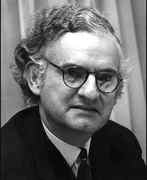Person: Lighthill, Michael James

James Lighthill was one of the foremost English applied mathematicians of his day. He worked on aerodynamics.
Mathematical Profile (Excerpt):
- Ernest Lighthill was 54 years old when James was born, and three years later, in 1927, he retired and returned to live in England.
- James was educated at Winchester College and, at the age of 15, he won a scholarship to Trinity College, Cambridge.
- While at Cambridge, Lighthill met Nancy Dumaresq who was studying mathematics at Newnham College.
- Lighthill tried to get a job in the Royal Aircraft Establishment at Farnborough after he graduated, since Nancy already had a job there.
- Lighthill was elected a fellow of Trinity College in 1945 and he held this fellowship until 1949.
- In 1950 Lighthill was promoted to Beyer Professor of Applied Mathematics at Manchester University.
- In 1959 Lighthill moved from Manchester to become director of the Royal Aircraft Establishment at Farnborough.
- In 1953 Lighthill had been elected as a fellow of the Royal Society of London and, in 1964, he became Royal Society Research Professor attached to Imperial College in London.
- Also at this time Lighthill, who had become unhappy with the support given to applied mathematics from government sources, founded the Institute of Mathematics and its Applications, becoming its first president in 1965-67.
- In 1969 Paul Dirac retired as Lucasian professor of Mathematics at the University of Cambridge and Lighthill was appointed to succeed him.
- Lighthill held the Lucasian chair for 10 years and was proud to hold the chair once held by Newton.
- He became Provost of University College London in 1979, Stephen Hawking succeeding him as Lucasian Professor of Mathematics at Cambridge, and Lighthill held this administrative post for 10 years until he retired in 1989.
- In this post Lighthill was much involved in fund raising but, despite a heavy administrative load, he continued his mathematical work studying chaotic systems, methods of extracting wave energy, and human hearing on which topic he gave the lecture Acoustic streaming in the ear itself at a conference on fluid dynamics in biology at Seattle in 1991.
- After Lighthill retired in 1989 he took on the position as chairman of the Special Committee on the International Decade for Natural Disaster Reduction which was sponsored by the International Council of Scientific Unions.
- Lighthill's mathematical publications began in 1944 with publications such as Two-dimensional supersonic aerofoil theory, The conditions behind the trailing edge of the supersonic aerofoil, and Supersonic flow past bodies of revolution.
- On this topic he gave Lighthill's eighth power law which states that the acoustic power radiated by a jet is proportional to the eighth power of the jet speed.
- Another new field introduced by Lighthill during his time as Royal Society Research Professor at Imperial College London was mathematical biofluiddynamics.
- Lighthill's classic text Waves in fluids was published in 1978.
- It should not be thought from this brief summary of Lighthill's work that he was interested only in applications of standard mathematical techniques.
- Lighthill certainly attracted attention in many ways such as in 1959 when he was fined £1 in a very public court case in which he was accused of jumping off a moving train.
- Many others would plead guilty to such an offence and pay the fine but not so Lighthill.
- Swimming was one of Lighthill's joys in life.
- Using a 'two-arm, two-leg backstroke, thrusting with the arms and legs alternately' he reached Grande Grève after two and a half hours, and shared a picnic lunch there with Lady Lighthill.
- Many honours from all parts of the world were bestowed on Lighthill during his distinguished career for his outstanding mathematical contributions.
- In 1961 Lighthill was elected a fellow of the Royal Aeronautical Society.
- Many universities have awarded Lighthill honorary doctorates including Liverpool (1961), Leicester (1965), Strathclyde (1966), Essex (1967), Princeton (1967), East Anglia (1968), Manchester (1968), Bath (1969), St Andrews (1969), Surrey (1969), Cranfield (1974), Paris (1975), Aachen (1975), Rensselaer (1980), Leeds (1983), Brown (1984), Southern California (1984), Lisbon (1986), Rehovot (1987), London (1993), Compiègne (1994), Kiev (1994), St Petersburg (1996), and Tallahassee (1996).
- Lighthill received the Commander Order of Léopold in 1963 and was knighted in 1971.
- Without the slightest doubt, during his watch, Lighthill succeeded in raising academic standards and in enhancing the international recognition accorded to University College.
Born 23 January 1924, Paris, France. Died 17 July 1998, Sark, Channel Islands.
View full biography at MacTutor
Thank you to the contributors under CC BY-SA 4.0! 

- Github:
-

- non-Github:
- @J-J-O'Connor
- @E-F-Robertson
References
Adapted from other CC BY-SA 4.0 Sources:
- O’Connor, John J; Robertson, Edmund F: MacTutor History of Mathematics Archive
